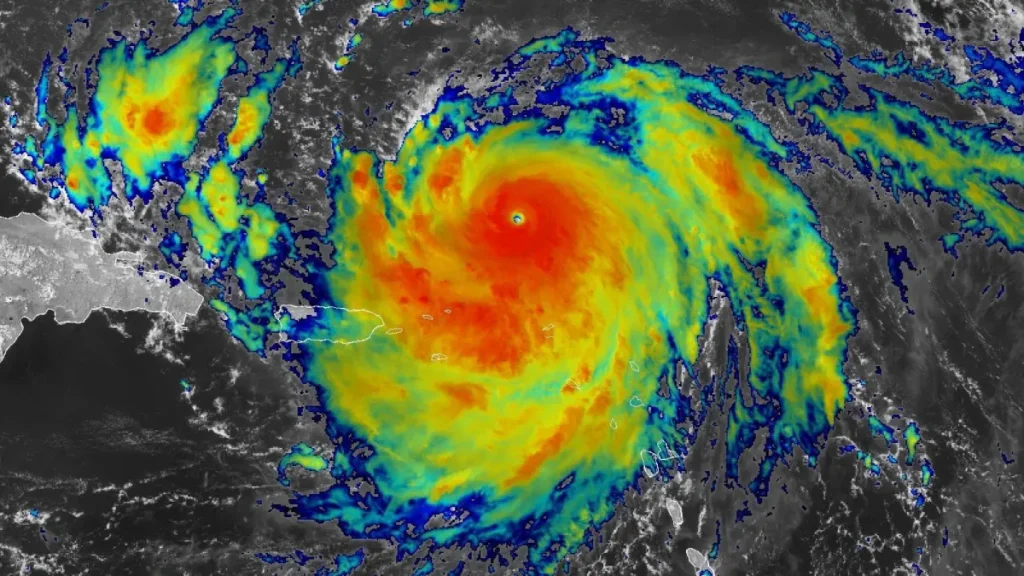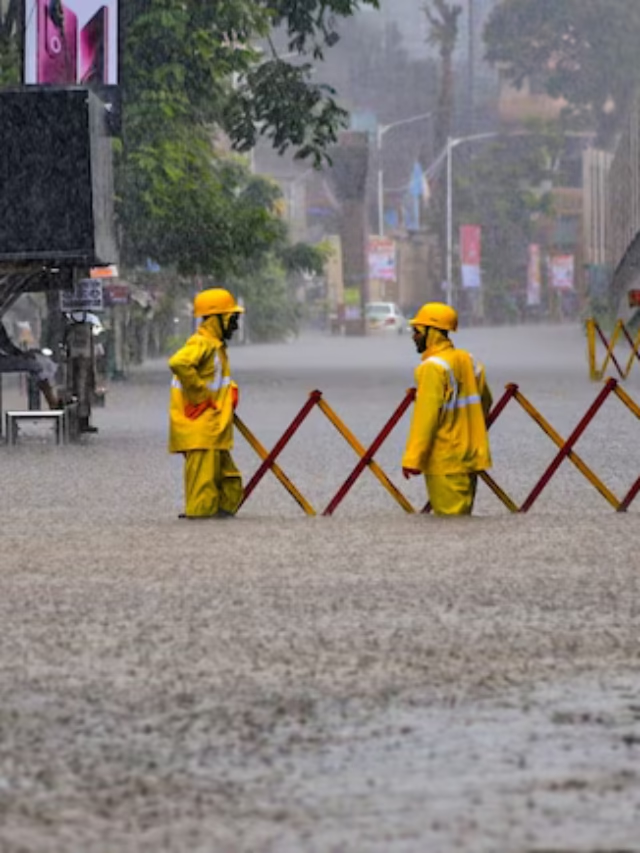
Hurricane Erin (2025) arrived in the Atlantic with the kind of energy that instantly focuses attention across weather desks, coastal communities, and shipping routes. Even for seasoned observers, Erin’s growth from a tropical disturbance to a high-end Hurricane Erin was a reminder that modern Atlantic storms can evolve quickly when ocean heat and atmospheric support align. This comprehensive guide explains Erin’s origins, why it intensified, how it affected island communities and coastlines, the hazards that linger even without a direct landfall, and the practical steps people can take to stay safe.
Key Takeaways
Large Wind Field Long-Period Swell Rip Current Risk Flooding Rains Eyewall Cycles Offshore ≠ No Impact
1) Where and how Erin formed
Many Atlantic hurricanes begin life as tropical waves rolling off the West African coast. Erin was no exception. Embedded within a deep plume of moisture and steered westward by subtropical highs, the system organized over very warm sea surface Hurricane Erin 2025 temperatures. As thunderstorms repeatedly pulsed around a tightening low-level circulation, the disturbance consolidated and earned a name. The decisive factor was not simply warm water near the surface, but the ocean heat content through depth, which provides a deeper reservoir of energy to fuel persistent convection even as the storm churns the upper ocean.
At first, the environment was characterized by relatively low vertical Hurricane Erin 2025 wind shear—meaning the winds did not change too much with height—and abundant mid-level humidity. Those ingredients help a nascent cyclone maintain a vertically stacked structure. Once an inner core formed and an eye started to clear, Erin’s central pressure fell and the winds accelerated. This phase often appears dramatic on satellite loops: the eyewall contracts, outflow intensifies,Hurricane Erin 2025 and the surrounding bands hook into the core like spokes on a wheel.
2) Why Erin intensified so quickly
Rapid intensification occurs when several Hurricane Erin 2025 supportive elements line up at the same time: high oceanic heat content; limited dry air intrusions; efficient upper-level outflow; and a compact, symmetrical core. Erin checked those boxes. The storm tapped warm waters and converted latent heat from condensing water vapor into Hurricane Erin 2025 mechanical energy, deepening the low. With robust outflow aloft, the storm ventilated efficiently—like an engine that can expel exhaust as quickly as it burns fuel—allowing additional bursts of convection to wrap around the center.
A second feature in Erin’s evolution was the eyewall replacement cycle (ERC). Major hurricanes often build a secondary outer eyewall; as it contracts, the inner eyewall collapses. Wind speeds may dip as the wind field broadens, after which the storm can re-intensify with a larger radius of maximum winds. To coastal residents, Hurricane Erin 2025 that often means a wider area experiences strong gusts and dangerous surf, even if the peak category briefly decreases during the swap.
3) Track guidance and the “offshore dilemma”
Forecast models frequently projected Erin turning northward before approaching the U.S. East Coast, keeping the center over open water. To non-meteorologists, that can sound like good news—and in many ways it is. But “offshore” does not eliminate risk. Large hurricanes act like gigantic swell factories. They push long-period waves toward Hurricane Erin 2025 coastlines hundreds of miles away, modulated by local bathymetry and tide cycles. The result can be life-threatening rip currents, beach erosion, overwash on barrier islands, and minor coastal flooding in vulnerable bays and estuaries.
Another nuance is timing. If swell peaks align with higher astronomical tides, low-lying roads and car parks near beaches can flood, especially around inlets or where dunes are already compromised from prior seasons. Even without formal tropical storm warnings on the mainland, marine interests and beachgoers must respect posted flags, heed lifeguards, and monitor local briefings.
4) Impacts on island communities
Erin’s feeder bands brought heavy downpours and gusty winds to parts of the northern Caribbean. In mountainous terrain, rainfall rapidly funnels into rivers and ravines, triggering flash floods and landslides. Power outages are common during such events as vegetation and saturated soils interact with utility infrastructure. Transportation also slows: airports implement ground stops or reroute flights, ferries are suspended, and small craft advisories escalate as seas become steep and confused.
Crucially, the pre-hurricane phase of a system can be dangerous. Before Erin fully consolidated, slow-moving thunderstorms associated with its disturbance stage produced destructive flooding in portions of island chains downwind of the African coast. Those early impacts Hurricane Erin 2025 underscore an important lesson: you do not need a formal hurricane to experience life-altering weather. Preparedness should begin when a disturbance is identified, not only when a cone graphic appears.
5) Day-by-day feel of a long-lived hurricane
| Period | What typically happens | What to watch |
|---|---|---|
| Disturbance stage | Clusters of storms consolidate; model spread is large; rainfall can already be intense. | Flash-flood risk, especially in urban basins and steep terrain; maritime advisories. |
| Intensification | Pressure falls, eye clears, winds ramp up; watches and warnings expand. | Supply runs, securing property, evacuation Hurricane Erin 2025 planning for surge-prone areas. |
| Major hurricane phase | Eyewall replacement cycles broaden wind field; seas grow dangerous over a wide area. | Marine closures, rip current alerts, beach erosion near high tide cycles. |
| Recurvature/offshore track | Storm arcs poleward; direct wind impacts lessen for some coasts. | Persistent swell, dune damage, minor Hurricane Erin 2025 coastal flooding where tides and waves align. |
| Post-tropical transition | Core becomes asymmetric; rain/wind shift; large wind fetch persists. | Hazardous seas linger beyond “storm over” headlines; debris and navigation hazards. |
6) Who is most at risk even without landfall?
- Beachgoers and swimmers: Rip currents are powerful, narrow rivers of water that pull away from the beach. They are often strongest near piers, jetties, and breaks in sandbars.
- Small craft and Hurricane Erin 2025 recreational boaters: Long-period swell creates deceptive, steep faces beyond the breakers. Inlets are particularly treacherous when outgoing tide meets incoming waves.
- Barrier island communities: Repeated wave run-up erodes dunes and can overwash low spots, damaging access roads and boardwalks.
- Flood-prone urban areas: Intense outer-band downpours overwhelm drainage quickly, especially where impervious surfaces dominate.
7) Preparedness and practical safety tips
For island residents
- Stock water, shelf-stable food, medications, pet supplies, flashlights, batteries, and a battery-powered radio.
- Charge phones and power banks Hurricane Erin 2025 document important papers in waterproof bags.
- Park vehicles away from flood-prone streets; avoid low crossings during downpours.
- After heavy rain, be alert for landslides on steep slopes and near cuttings.
For U.S. East Coast visitors and locals
- Swim only at guarded beaches; obey flag systems; when in doubt, do not go out.
- Keep distance from piers and jetties; rogue waves can knock you into turbulent water.
- Check tide times and local briefings; park away from low waterfront lots during peak tides.
- If caught in a rip current: stay calm, float, and swim parallel to shore to exit the current before angling back in.
8) Climate context: what Erin says about the modern Atlantic
No single hurricane can be “blamed” on climate change, but the backdrop matters. Warmer oceans store more energy; a moister atmosphere wrings out heavier rain; and seasons with persistent low shear windows allow more storms to reach high intensity. Erin’s behavior—rapid strengthening over high oceanic heat content, then fluctuating as eyewall cycles broadened the wind field—fits with patterns closely watched by researchers. For coastal planners, that means preparing not only for direct landfalls but also for the large-footprint swell events that accompany offshore tracks.
Another evolving theme is compounding hazards. A community may endure multiple rounds of beach erosion over several seasons, gradually lowering dunes and making subsequent swell events more damaging. Likewise, repeated outer-band flood episodes can stress infrastructure even in years without a direct strike. Adaptation—smarter zoning, living shorelines, elevating critical equipment—pays dividends across storm years.
9) Frequently asked questions
Is “Category” the only thing that matters?
No. Category measures peak sustained Hurricane Erin 2025 wind speed, not rainfall, storm size, surge potential, or duration. A large Category 2 with deep swell can be more hazardous to beaches than a compact Category 3 that passes quickly. Always read the full hazard discussion, not merely the category tag.
Why do forecasts change?
Storms interact with their environment: wind shear, dry air, ocean eddies, and nearby weather systems. New data from satellites, aircraft, and ocean buoys continually feed models, refining the track and intensity outlook. Small shifts can mean big differences in who experiences the worst surf or heaviest rain.
How long do rip current risks last after the storm moves away?
Swell can lag the storm by days. Beaches may remain hazardous even under sunny skies. Local lifeguard agencies usually update risk levels daily; check before you go.
10) The takeaway for readers and editors
Hurricane Erin 2025 showcased the modern Atlantic playbook: swift organization over very warm water, a burst to major-hurricane strength, eyewall cycling that broadened hazards, and an offshore track capable of sending dangerous surf along a wide stretch of coastline. For residents and travelers, the message is consistent—prepare early, respect water, and get information from official channels. For planners, the lesson is to view storms not as isolated events but as part of a recurring coastal-risk pattern that deserves sustained investment in resilience.
Whether you live on an island where mountain slopes meet the newssea or along a temperate barrier island with long, sandy beaches, the same truths apply: water is powerful, preparedness is practical, and awareness saves lives. Erin will eventually fade from headlines, but the footprints it leaves—in dunes reshaped, infrastructure tested, and communities reminded of their vulnerability—should inform how we approach the rest of the season and the years to come.










